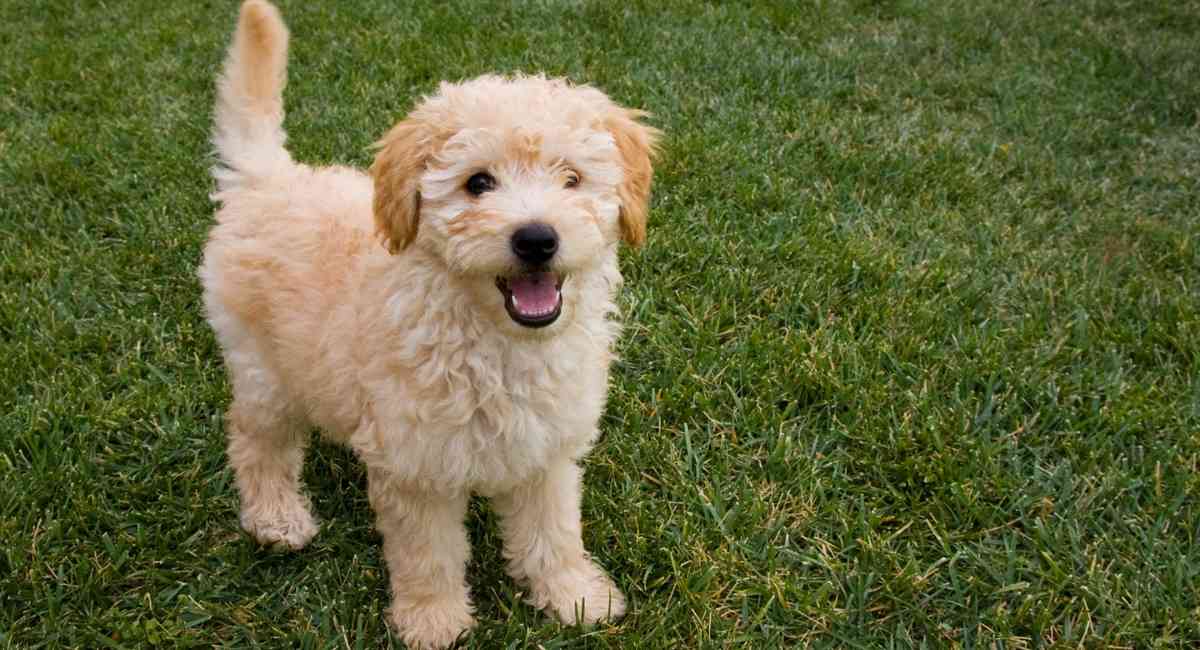One question many new Goldendoodle puppy owners ask is how big will my Goldendoodle get? The height and weight of this mixed-breed dog can vary greatly. But, to give you a rough sense of sizing, Goldendoodles commonly classified as miniature or mini (also includes “toy” and “medium” sizes) average 15 to 45 pounds and 12-17 inches in height, while standard Goldendoodles average 45 to as much as 100 pounds and 17-24 inches in height.
Soon after birth, Goldendoodles undergo a rapid growth spurt and ultimately go through seven growth stages. In this guide, we will inspect the life and growth cycle of the Goldendoodle so you can know what to expect.
Size Predictions
As the Goldendoodle is a crossbreed of the Golden Retriever and Poodle, the variation in the sizes are significant, primarily driven by the Poodle side of its lineage (Poodles range in size much more so than Golden Retrievers). The American Kennel Club recognizes three breeds – differentiated mostly on size – of Poodle: Standard, Miniature, and Toy. Each of these Poodle breeds can be crossbred with a Golden Retriever to produce Goldendoodle offspring.
But you don’t need to worry because we can estimate the final adult size of the puppy with some simple guesses based on their growth patterns.
So How Big Will My Goldendoodle Get?
Most of the owners get their puppies when they’re around 8-weeks old. It’s difficult to tell which puppy will grow up faster than the others.
Common sense tells us that the smallest puppy will grow up to be the smallest out of the litter. But that is not always the case. Many puppies have different growth rates, resulting in different adult weights.
Goldendoodles reach their maximum size and height between one to two years old. The time can vary since puppies don’t all grow at the same rate. The growth curves of the mini, medium, and standard Goldendoodle differ from each other, meaning their final weights are also different.
At 8-weeks old, the mini Goldendoodle will weigh around three to nine pounds. For medium Goldendoodles, it’s eight to 10 pounds. And a standard Goldendoodle puppy will typically weigh around 10 to 20 pounds.
Week 8:
At 8-weeks, they almost weigh around 29% of their total body weight. You can calculate your puppy’s weight by multiplying their weight at week eight by 4.3. If your puppy weighs around eight pounds, your adult Goldendoodle will weigh 34.4 pounds.
Week 12:
When your puppy is 12 weeks old, you will see a massive shift in weight gain and growth. They will have achieved 40% of their total adult weight. To multiply their weight at 12 weeks, you usually multiply their weight times three to calculate their adult weight range.
Week 16:
Your puppy should reach around half of its total adult weight by this time. To calculate the approximate weight, multiply the weight by 2 to predict the adult weight.
Week 24:
At this stage, the Goldendoodle will weigh approximately 75% of its total adult weight. If you multiply the weight by 1.26, you can predict the future weight of the dog.
Week 40:
Now your Goldendoodle will have achieved 90% of its total adult weight. The massive growth spurt that you were observing will slow down.
They won’t gain a ton of weight each week now. And the growth rate decreases. Multiply the current weight with 1.14 to get an approximate adult weight of the dog.
Week 52:
A Goldendoodle keeps on gaining weight right up to its second birthday. But by the time it reaches its first birthday, it should weigh around 65 pounds. At this point, you should still consider it a puppy and keep on feeding it puppy food.
The appetite slows down. And you will notice it as well. As soon as it crosses the 54 or 55-week mark, you can transition to adult food for your puppy.

Does Diet Affect a Goldendoodle’s Growth?
There are many factors in play that affect the dog’s growth. Diet is one of them. If a dog isn’t fed properly, it cannot achieve its proper weight and size.
The same is true for a Goldendoodle. If you are not on top of its diet, it will never grow up to be the healthy dog it’s supposed to be.
Since standard Goldendoodles are considered large dogs, it takes time for them to reach their full size. There are many phases during the growth process where your doodle will stop gaining weight.
On average, a dog takes around one and a half years to achieve its maximum size and growth. Goldendoodles only take 12 months. That’s a massive difference. To achieve this kind of growth diet plays a crucial role.
Among the Goldendoodles, a standard size Goldendoodle has a faster growth rate than the mini or toy Goldendoodle. But all of them show a tremendous growth rate between the third and six months of age.
What Are the Different Types of Goldendoodle?
This is a very complex topic, and few categories have been defined to address this issue. But in general, The Goldendoodle Association of North America divides them into 4-major categories:
Toy Goldendoodle
The Toy Goldendoodle has an adult weight of about 25 pounds and under. They reach their adult weight around 10-months.
They are petite, and often rare. They are friendly and develop a strong bond with the owners. Since they are so intelligent, they also develop an easy understanding of their family. Thanks to their small size, they also make a perfect apartment puppy.
Miniature Goldendoodle
Mini doodles have become very popular because of their small size, intelligence, social skills, and temperament. They are approximately 13 to 20 inches in height, but their weight has a pretty wide range. They are friendly dogs so they might not be the best choice for introverts.
Medium Goldendoodle
An adult medium Goldendoodle can range between 30 to 50 pounds. It is quite a wonderful mix between the bigger standard one and the mini Goldendoodle. They fit well in cars so you can easily take them along on the next family vacation.
This dog loves going out and is very social. If you jog or walk a lot, this might be the perfect Goldendoodle for you.
Standard Goldendoodle
A standard Goldendoodle has a height range of 20 to 24 inches is a friendly, intelligent, and confident dog. It has an adult weight of at least 65 pounds and will keep on growing. The standard Goldendoodle is capable, making them the perfect companion and family pet.
How to Best Support the Dog’s Growth?
Diet and nutrition can play a key role in the growth of your Goldendoodle. Many things should be kept in mind when supporting their development. The top priority of any dog’s growth after the diet is its mental health.
Yes, every living organism can feel. Since dogs are no exception, you must keep it away from distressing situations. A happy and healthy dog is a good indicator of a happy and healthy family.
You must keep regular appointments with the vet to ensure that the dog’s growth is on the right track. Train your dog, take him out on walks, brush and bathe him regularly. These little things can significantly impact your dog’s mental and physical health.
How Does Health Affect a Goldendoodle’s Growth?
Goldendoodles are a healthy crossbreed but are susceptible to some health conditions that can hinder their growth. Goldendoodle, being a crossbreed, can develop conditions common to both the Poodle and the Golden Retriever. These include:
Hip Dysplasia
It is an inherited condition where the bone doesn’t fit right into the hip joint. Pain, numbness, and lameness of the leg are common symptoms. Arthritis follows suit. Dogs with this condition are not healthy to breed. You should ask for evidence that the parents are free of this illness.
Allergies
Almost every dog suffers from allergies, and the Goldendoodles are no exception. Three types of allergies affect dogs. The most common one is a food allergy.
Not every kind of food is suitable for every dog. However, you can treat it by changing the foods that lead to this ailment. Topical allergies because of pollen are also quite common among dogs.
Elbow Dysplasia
It is very similar to Hip Dysplasia, as it is also prone to arthritis. It is a degenerative and inherited disease of joints that can cause limping pain, numbness, and tenderness over the joint. Surgery, anti-inflammatory medications, and pain management therapy are good treatment options for dogs suffering from elbow dysplasia.
Gastric Dilatation
A medical term called bloating is a serious health condition, especially for big, old dogs. The condition happens when a dog takes on an enormous meal, drinks large quantities of water, and exercises.
Gas collects in the stomach. And the dog can’t vomit nor belch to get rid of the excess gas from the stomach. The BP drops drastically, and the danger of shock lurks around.
The best way to recognize whether your dog has a bloated stomach is to check for excessive salivation, retching, lethargy, restlessness, and weakness. Call and consult the vet immediately since an immediate treatment can save the dog’s life.
Now, please note that not every Doodle suffers from these health conditions. If you make sure to adopt a healthy Goldendoodle, your pup might never get any of these diseases.
Tips for Buying a Healthy Goldendoodle
The breeder plays an important role when you are out looking for a puppy. A good breeder will always be open about the health conditions of the puppy and the prevalence of the diseases in it.
When you look for a Goldendoodle puppy, ask for evidence whether the parents have a hip clearance from the Orthopedic Foundation of Animals. For a standard Doodle, check for OFA elbow clearance and a knee clearance for mini and medium-size Goldendoodles. Also make sure to check out the Ribbons requirements set by the Goldendoodle Association of North America.
If adopting a Goldendoodle, for surety, take your newly adopted dog straight to the vet so that he can examine your dog. If he spots any underlying health conditions, you can take preventive measures to help your dog lead a better life.
Also, take special care with dental hygiene. This is especially true for the toy Goldendoodle breed that suffers from many dental problems.

Do Training and Care Affect a Dog’s Growth?
Mental and physical health are prominent, influential factors in your dog’s growth. A Goldendoodle is a large dog, and it loves walking, running, and jogging.
It is not a proper apartment dog and shouldn’t be kept behind closed doors all the time. That can affect its growth curve since they’re an intelligent and social dog.
A Goldendoodle is easier to train than the other dogs of their size. They’re a playful dog and loves pleasing their trainers. They want to be your best friend.
Another point to be kept in mind as its owner is that they can suffer from separation anxiety if left alone for too long. To remove any shyness and timidity, socializing can also help a lot.
How Does Gender Affect the Dog’s Growth?
Many dogs show a characteristic called sexual dimorphism. It refers to how physical features can differ between male and female dogs of the same species.
In the case of dogs, the male dogs have a slightly taller physique than their female counterparts. It is quite visible, and you can easily differentiate between the two.
When Will My Doodle Stop Growing?
Most dogs can take around one to two years to reach their adult size and weight. They reach their maximum height by the end of their first year. However, since Goldendoodles are a crossbreed, they have a varied growth curve. This means their final adult size can vary.
Golden retrievers take around 14-18 months to reach their final adult size. The poodles may take up to 2 years to reach their adult size.
Since there are many forms of Goldendoodle out there, on average, a Goldendoodle stops growing around one and a half years of age. They reach their final adult size right around 12 months, but they will still continue gaining weight and filling out.
You can predict the size and weight by the techniques mentioned above. But they are not the absolute measure of the adult size of your Goldendoodle.
Why You Shouldn’t Overfeed a Dog?
While a healthy diet can improve the growth curve of your dog, a diet rich in carbs can ruin it. It is the main reason dogs all around the US are getting obese.
One of the major reasons for this is that carbs are a cheap alternative to protein diets. And many owners use the carb diet to make up for the pricey protein.
To improve their healthy weight, try a high-fiber diet. Fibers do not get converted and stored as fats in dogs, so they make them feel full on less food.
The best way to check whether your dog is overweight is to rub your hand over its back so that you can feel its spine. If you can, then there’s no need to worry. If you can’t, you need to cut the extra weight and start a good exercise routine for your dog.
You can find some good high-fiber diets listed here.
Frequently Asked Questions
How long will it take for a Goldendoodle to achieve adult size?
At around 1 to 2 years old, Goldendoodles reach their maximum size and height. However, some puppies take longer to attain weight than others. The growth curves of the mini, medium, and standard Goldendoodles are different and their final weights also differ.
What is the lifespan of a Goldendoodle?
Their Golden Retriever and Poodle parent breeds give them a lifespan of 10 to 15 years.
Which are better: female or male Goldendoodles?
Females tend to be more tense, nervous, and reactive than their male counterparts. Especially after neutering, males are more relaxed and calmer. They tend to focus more on their handlers and eat more frequently after neutering.
Final Thoughts
After reviewing all the data available to us, we can conclude that the Goldendoodle, on average, reaches 98% percent of its adult weight and size by 52 weeks (one year). Since there are many types of Goldendoodle, the final size and weight can vary.
Many factors play a role in its growth, the most important being diet and health. A healthy and fit dog will have a healthy growth curve. It will reach all its milestones on time. But it’s important to remember that the final size of every dog can vary. But if you keep these above points in mind, you can easily predict how big your Goldendoodle will get.

